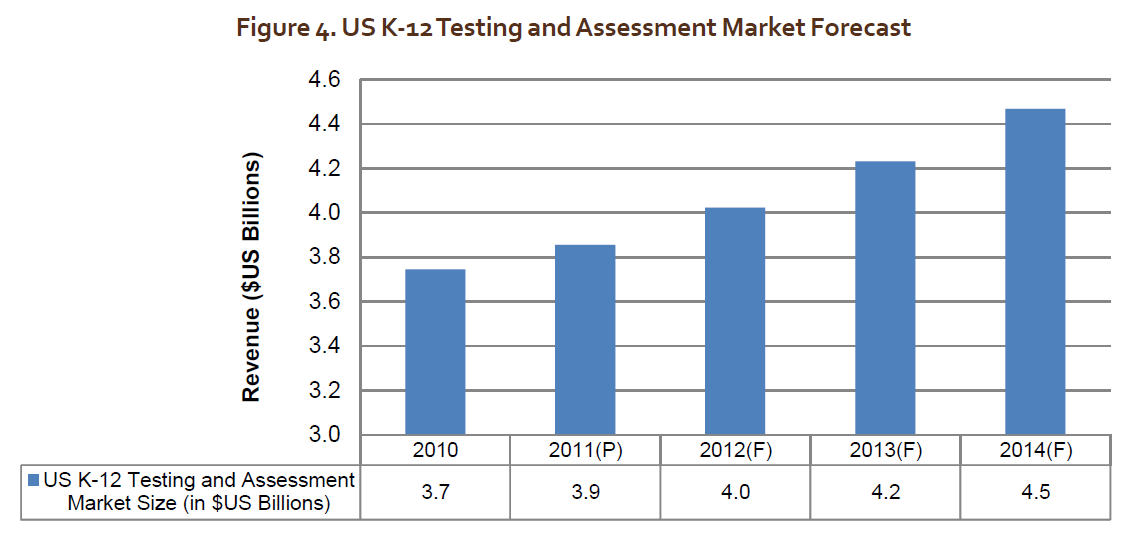Analysts See a Bountiful Market for K-12 Testing Companies
These appear to be heady times for the assessment industry—maybe not rising to the level of the test-fueled years immediately following the passage of the No Child Left Behind Act, but life is good for those companies, nonetheless.
That was the conclusion of many industry officials and K-12 analysts I spoke with for a story in the current issue of Education Week, which examines the state of the testing market.
So what’s behind the market growth?
One obvious factor at work is the scramble to prepare for the common-core tests. While the most visible work in creating those tests is being conducted by two consortia of states, schools and districts—some worried about seeing their students’ test scores drop once the new exams are in place—are buying up testing and curricular tools that will help prepare teachers and students for the challenge ahead.
Another force behind the testing market’s growth: the continued demand for formative assessments, or tools that allow teachers to assess student skills on the fly and make real-time adjustments to meet their needs. Tests offered throughout the academic year or semester, alternately labeled interim, benchmark, or “embedded” assessments, are also on the rise.
“The demand is strong, and growing, as we get closer to the the 2014-2015 common-core assessments,” said Ellen Haley, the president of CTB McGraw-Hill, in a recent interview.
Here’s a recent projection of the K12 testing market’s future growth, produced by Outsell:

The No Child Left Behind Act, signed into law in 2002, unleashed a wave of assessment products as states and districts scrambled to meet goals for bringing students to targets for academic proficiency at many grade levels, and faced penalties if they did not reach academic goals.
But now, more states will be judging schools on how well they help students make academic progress over time, rather than simply hitting specific targets. That shift—encouraged by policies such as the waivers provided to states from No Child Left Behind by the Obama administration—is also occuring as states and districts experiment with “next-generation” assessments, designed to more precisely gauge what students know, in greater depth.
“No Child Left Behind is still the law, [but] you can see what the future is here,” Haley explained. “We are moving away from the No Child Left Behind, ‘Every-child-must-be-proficient-by-this date.’…We’re building next-generation assessments.”
The CTB McGraw-Hill official, echoing the views of some other education company executives I interviewed, says the assessment industry is experiencing a spike as state and local officials scramble to prepare for common-core tests, while states’ individual tests remain on the books for now. The growth is likely to continue as states prepare for the implementation of the common-core tests, scheduled to be administered online in 2014-15, Haley predicted.
The effort to develop tests aligned to the common core is being led by a pair of consortia of states: the Partnership for Assessment of Readiness for College and Careers and the Smarter Balanced Assessment Consortium. Those consortia are overseeing much of the heavy lifting in launching the tests, and they have awarded numerous lucrative contracts to major education companies to help them, including CTB McGraw-Hill.
But Haley and others also pointed out that a major chunk of the common-core testing business is still flowing directly from the states, because they are responsible for handling various pieces of administering the new exams.
For members of the Smarter Balanced consortium, state responsibilities will include delivering the tests, hosting testing platforms, and producing special reports that comply with state accountability requirements, explained Joe Willhoft, the executive director of the consortium.
So while the consortia have put out requests for proposals for services, states are also putting out their own RFPs, creating opportunities for testing providers and other companies, he said.
“States have told us that they wanted to retain as much autonomy as they could…while also taking advantage” of the services Smarter Balanced can provide, Willhoft said.
For testing companies, that means there’s money to be made at the state level, and in local districts. Whether this results in tests that lead to improved classroom instruction or academic gains remains to be seen.
[Correction: The original version of this post misspelled the name of Joe Willhoft of the Smarter Balanced Assessment Consortium.]
